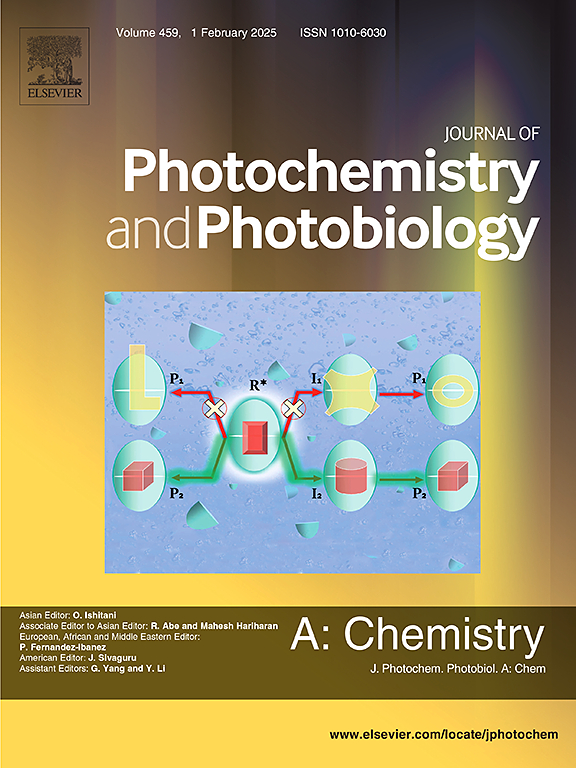Aggregation-induced emission of silver nanoclusters induced by Li+ for white light emitting diodes
IF 4.1
3区 化学
Q2 CHEMISTRY, PHYSICAL
Journal of Photochemistry and Photobiology A-chemistry
Pub Date : 2025-04-16
DOI:10.1016/j.jphotochem.2025.116444
引用次数: 0
Abstract
Because of the increasingly depleted global resources, light-emitting diodes (LEDs) have emerged as one of the most appealing lighting systems, among which metal nanoclusters (NCs) are regarded as one of the most promising phosphors for color conversion in LEDs. However, dispersed metal NCs often exhibit drawbacks such as low emission intensity, which can be remedied by aggregation-induced emission (AIE) induced by self-assembly strategy. In this study, based on a water-soluble silver NCs (((NH4)9[Ag9(mba)9], H2mba = 2-mercaptobenzoic acid, hereafter referred to as Ag9 NCs) with atomically precise structure, the precipitation of yellow nanorods with strong luminescence is generated under Li+ coordination for the first time. Compared to Ag9 NCs, the Ag9 NCs/LiNO3 composites demonstrate significantly enhanced luminescence performance, realizing an increase in quantum yield from zero to substantial levels (7.8%) and achieving a large Stokes shift of 262 nm, which is much larger than the Stokes shift of Ag9 NCs composite materials reported in most articles (160 nm). Furthermore, the fluorescence lifetime has been extended by 254 times, from 3.2 ns to 834.7 ns, the long lifetime and large Stokes shift imply that it is phosphorescence emission. Due to its exceptionally strong photoluminescence intensity, it can be mixed with the commercial phosphor for used as a white phosphor. The study shows that the superior optical qualities of Ag9 NCs/LiNO3 composites are of great application value in the manufacture of white LEDs, which opens a wider range of potential uses for Ag NC in the optical device industry.

白色发光二极管中Li+诱导银纳米团簇的聚集诱导发射
由于全球资源的日益枯竭,发光二极管(led)已成为最具吸引力的照明系统之一,其中金属纳米团簇(nc)被认为是led中最有前途的颜色转换荧光粉之一。然而,分散的金属纳米材料往往存在发射强度低的缺点,这可以通过自组装策略引起的聚集诱导发射(AIE)来弥补。本研究以具有原子精密结构的水溶性银NCs (((NH4)9[Ag9(mba)9], H2mba = 2-巯基苯甲酸,以下简称Ag9 NCs)为基础,首次在Li+配位下生成了强发光黄色纳米棒的沉淀。与Ag9纳米碳化物相比,Ag9纳米碳化物/LiNO3复合材料的发光性能得到了显著提高,量子产率从零提高到相当高的水平(7.8%),并实现了262 nm的大Stokes位移,远远大于大多数文献报道的Ag9纳米碳化物复合材料的Stokes位移(160 nm)。荧光寿命延长了254倍,从3.2 ns延长到834.7 ns,长寿命和大Stokes位移表明它是磷光发射。由于其极强的光致发光强度,可与商用荧光粉混合作为白色荧光粉使用。研究表明,Ag NC /LiNO3复合材料优越的光学品质在白光led的制造中具有很大的应用价值,这为Ag NC在光学器件行业开辟了更广泛的潜在用途。
本文章由计算机程序翻译,如有差异,请以英文原文为准。
求助全文
约1分钟内获得全文
求助全文
来源期刊
CiteScore
7.90
自引率
7.00%
发文量
580
审稿时长
48 days
期刊介绍:
JPPA publishes the results of fundamental studies on all aspects of chemical phenomena induced by interactions between light and molecules/matter of all kinds.
All systems capable of being described at the molecular or integrated multimolecular level are appropriate for the journal. This includes all molecular chemical species as well as biomolecular, supramolecular, polymer and other macromolecular systems, as well as solid state photochemistry. In addition, the journal publishes studies of semiconductor and other photoactive organic and inorganic materials, photocatalysis (organic, inorganic, supramolecular and superconductor).
The scope includes condensed and gas phase photochemistry, as well as synchrotron radiation chemistry. A broad range of processes and techniques in photochemistry are covered such as light induced energy, electron and proton transfer; nonlinear photochemical behavior; mechanistic investigation of photochemical reactions and identification of the products of photochemical reactions; quantum yield determinations and measurements of rate constants for primary and secondary photochemical processes; steady-state and time-resolved emission, ultrafast spectroscopic methods, single molecule spectroscopy, time resolved X-ray diffraction, luminescence microscopy, and scattering spectroscopy applied to photochemistry. Papers in emerging and applied areas such as luminescent sensors, electroluminescence, solar energy conversion, atmospheric photochemistry, environmental remediation, and related photocatalytic chemistry are also welcome.

 求助内容:
求助内容: 应助结果提醒方式:
应助结果提醒方式:


